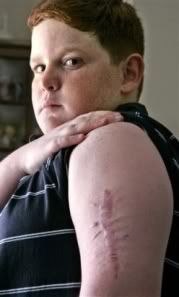MELANOMA In Children
Rise of Melanoma in Kids Alarming DoctorsBy LINDSEY TANNER, AP Medical Writer CHICAGO - Doctors used to think that it took years for the deadliest skin cancer to develop — that is, until melanoma started appearing in teenagers and children even younger.  Corey Halpin of Hanover Park was one of them. At age 10, he noticed a dark bump on his upper left arm, thinking during a Boy Scout camping trip that it might even be a tick. Corey Halpin of Hanover Park was one of them. At age 10, he noticed a dark bump on his upper left arm, thinking during a Boy Scout camping trip that it might even be a tick. "I pushed it but it didn't move, but it bled," Corey, now 13, recalled. It wasn't until a few months later, during a spring 2002 visit to his pediatrician, that Corey casually asked his dad if he should mention the odd mole. That led to a referral to a specialist and alarming test results that caught even his doctors by surprise. Melanoma was until recently almost unheard of in children, and it was a diagnosis that his family wasn't prepared for. "My husband and I were scared to death" and so was Corey, said his mother, Marge Halpin. Pediatric melanoma is still uncommon in children, affecting only 7 per million, or about 500, according to 2002 statistics from the National Cancer Institute. But that number has risen from 3 per million in 1982. Dr. Charles Balch of the American Society of Clinical Oncology, who has specialized in melanoma for 30 years, saw his first pediatric case five years ago. Since then, Johns Hopkins Hospital, where he works, has treated about 20 youngsters, the youngest just 8. Dr. Anthony Mancini, dermatology chief at Children's Memorial Hospital in Chicago, diagnosed Corey Halpin's melanoma and said he and his colleagues have treated eight cases in the past nine years, about double the number seen in the previous two decades. Recent studies also report increases in England, Sweden and Australia. "There's an appropriate level of alarm here," Mancini said. "Clearly it's happening and it's deadly, and it's missed." Some pediatricians who see unusual moles in children "would ordinarily dismiss this as nothing because melanoma is not supposed to happen in this age group," Balch said. "We all should be aware that this can occur and biopsy suspicious or changing moles in children." Balch said reasons for the increase are uncertain. Some doctors think it might be from depletion of the ozone layer, which protects the Earth from some of the sun's damaging ultraviolet radiation. Others attribute it to excessive sun exposure and blistering sunburns in early childhood, though some experts had thought it took much longer for skin damage from repeated sun exposure to develop into cancer. Melanoma prevalence has risen in adults, too — more than doubling in the past 30 years, according to the cancer institute. And the American Cancer Society estimates that this year about 60,000 U.S. adults will be diagnosed with melanoma and that 7,700 will die from it. Melanoma develops in skin cells called melanocytes, which produce the pigment that colors the skin's surface and protects deeper layers from sun damage. It is much more invasive and likely to spread to other parts of the body than other skin cancers. Research from Italian doctors published in the March edition of Pediatrics found that melanoma lesions in children sometimes look different from those in adults and may be misdiagnosed. In adults, melanoma often looks like a black or very dark brown mole, or one with irregular borders. But half the Italian children studied had lighter-colored lesions, and most had well-defined borders. Also unlike adults, most children with melanoma have no family history of the disease, and they may lack other risk factors including moles present since birth, Balch said. Freckle-faced Corey has no relatives with melanoma or any other kind of cancer. But he does have other risk factors — fair skin, red hair and green eyes. Mancini, his doctor, says the traditional A-B-C-D signs of melanoma — asymmetry, border irregularities, colors of mixed black and brown, and diameters larger than a pencil eraser — sometimes occur in children. But a child's lesion also can be smaller and pinkish. Mancini recommends the "ugly duckling" detection method — watching for a mole that looks completely different from the child's other moles. In Corey's case, the mole was tiny but much darker than his other freckles, and it bled — another warning sign. Three years since his surgery, Corey is cancer-free. He still has tests every few months, but doctors say his long-term survival chances are excellent. The angry scar on his arm has shrunk as he's grown but it will always be a reminder. His pediatrician told him that it would be like a battle scar he could use to impress girls. Now 13, Corey smiles at that thought. |

















<< Home